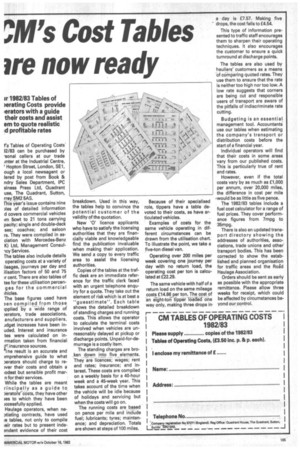TM's cost Tables
Page 81

If you've noticed an error in this article please click here to report it so we can fix it.
ire now ready.
Jr 1982/83 Tables of )erating Costs provide lerators with a guide their costs and assist em to quote realistic id profitable rates
l's Tables of Operating Costs' 12/83 can be purchased by .sonal callers at our trade
inter at the Industrial Centre, Hopton Street, London, SE1, ough a local newsagent or Iered by post from Book & ndry Sales Department, IPC siness Press Ltd, Quadrant use, The Quadrant, Sutton, rrey SM2 5AS.
This year's issue contains nine ales of detailed information d covers commercial vehicles im 5cwt to 21 tons carrying pacity; single and double-deck ses; coaches; and saloon rs. They were compiled in asciation with Mercedes-Benz 10 Ltd, Management Consulicy Services.
The tables also include details operating costs at a variety of ileages, journeys per day and ilisation factors of 50 and 75 ir cent. There are also tables of tes for these utilisation perceng es for the commercial
The base figures used have 3 en compiled from those_ ipplied by a wide range of aerators, trade associations, anufacturers and suppliers. Jdget increases have been inuded. Interest and insurance tes were calculated on inrmation taken from financial
insurance sources.
ne result is an accurate and )mprehensive guide to what aerators should charge to rewer their costs and obtain a lodest but sensible profit marn for their services.
While the tables are meant rincipally as a guide to Deratoisi costs, they have other ;es to which they have been iccessfully applied.
Haulage operators, when neatiating contracts, have used le tables, not only to compile lair rates but to present indesndent evidence of their cost breakdown. Used in this way, the tables help to convince the potential customer of the validity of the quotation.
New '0' licence applicants who have to satisfy the licensing authorities that they are financially viable and knowledgeable find the publication invaluable when making their application. We send a copy to every traffic area to assist the licensing authorities.
Copies of the tables at the traffic desk are an immediate reference for the traffic clerk faced with an urgent telephone enquiry for a quote. They take out the element of risk which is at best a "guesstimate". Each table shows the detailed breakdown of standing charges and running costs. This allows the operator to calculate the terminal costs involved when vehicles are unreasonably delayed at pickup or discharge points. Unpaid-for-demurrage is a costly item.
The standing charges are broken down into five elements. They are licences; wages; rent and rates; insurance; and interest. These costs are compiled on a weekly basis for a 40-hour week and a 45-week year. This takes account of the time when the vehicle will be idle because of holidays and servicing but when the costs will go on.
The running costs are based on pence per mile and include fuel; lubricants; tyres; maintenance; and depreciation. Totals are shown at steps of 100 miles. Because of their specialised role, tippers have a table devoted to their costs, as have articulated vehicles.
Examples of costs for the same vehicle operating in different circumstances can be drawn from the utilisation chart. To illustrate the point, we take a five-ton diesel van.
Operating over 200 miles per week covering one journey per day with no return load, the operating cost per ton is calculated at £22.29.
The same vehicle with half of a return load on the same mileage _costs £14.86 per ton. The cost of an eight-ton tipper lodd one way only, making three drops in
a day is E7.57. Making five ' drops, the cost falls to £4.54.
This type of information presented to traffic staff encourages them to sharpen their operating techniques. It also encourages the customer to ensure a quick turnround at discharge points.
The tables are also used by hauliers' customers as a means of comparing quoted rates. They use them to ensure that the rate is neither too high nor too low. A low rate suggests that corners are being cut and responsible users of transport are aware of the pitfalls of indiscriminate rate cutting.
Budgeting is an essential management tool. Accountants use our tables when estimating the company's transport or distribution costs before the start of a financial year.
Individual operators will find that their costs in some areas vary from our published costs. This is particularly true of rent and rates.
However, even if the total costs vary by as much as £1,000 per annum, over 20,000 miles, the difference in cost per mile 'would be as little as five pence.
The 1982/83 tables include a fuel cost calculator for a range of fuel prices. They cover performance figures from 7mpg to 35mpg.
There is also an updated transport directory showing the addresses of authorities, associations, trade unions and other transport bodies. This has been corrected to show the established and planned organisation for traffic areas and the Road Haulage Association.
Orders should be sent as early as possible with the appropriate remittance. Please allow three weeks for receipt, which could be affected by circumstances beyond our control.




















































































